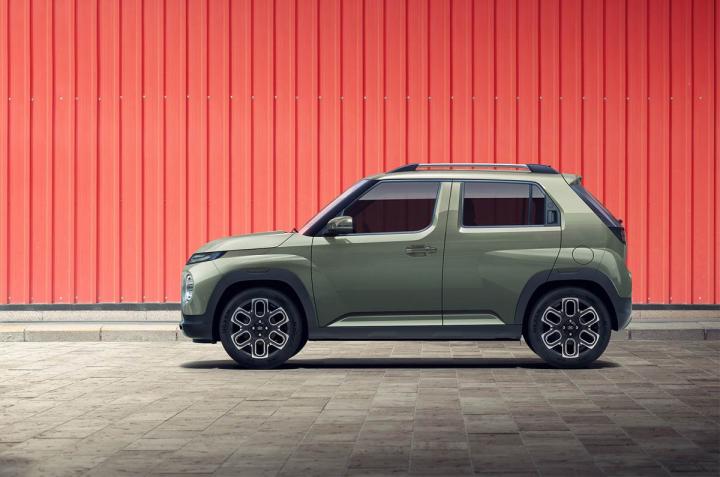News
Hyundai plans Ai3 compact SUV to rival Tata Punch
The Ai3 will be Hyundai's entry-level SUV model that will be positioned below the Venue.
According to a media report, Hyundai plans to enter the entry-level sub-4 metre SUV segment to compete with models like the Tata Punch.
The report states that Hyundai has internally approved funding for the new model (codenamed: Ai3). While details about the new 'CUV' are scarce, it is likely to arrive in 2023.
Now, Hyundai had revealed the Casper micro-SUV for the global markets in 2021. If we were to speculate, the Ai3 could be a heavily localized version of the Casper.
The Casper is designed to comply with the Gyeoncha (light car) regulations in the South Korean market. It is offered with two petrol engine options. These include an 85 BHP 1.0-litre naturally-aspirated engine and a more powerful 1.0-litre turbo-petrol unit churning out 99 BHP.
Source: ET Auto
- Tags:
- Indian
- Casper
- Hyundai AX1
- Tata Punch
- Punch
News
Rumour: Hyundai Casper may not come to India
The Casper is seen as a worthy rival to the upcoming Tata Punch.
Hyundai's quirky-looking Casper micro-SUV was unveiled earlier this month. While it is seen as a worthy rival for the upcoming Tata Punch, a media report suggests that Hyundai may not launch it in India.
The report states that the micro-SUV is specifically developed for the Korean market. It is designed to comply with the Gyeongcha (light car) regulations, which require cars to be under 3.6-meters in length.
The sub-4 meter SUV segment in India is pretty popular. However, Hyundai believes the Casper's ultra-compact size will not be right for the Indian market.
In the international market, the Casper is available with two petrol engine options. These include an 85 BHP 1.0-litre naturally-aspirated engine and a more powerful 1.0-litre turbo-petrol unit churning out 99 BHP. The Casper will come with both manual and automatic transmission options.
Source: Powerdrift
- Tags:
- Indian
- Casper
- Hyundai AX1
News
Hyundai Casper engine options leaked; to rival Tata Punch
In India, the Casper will lock horns with the Tata Punch and the Maruti Suzuki Ignis.
Hyundai Casper is Korea's answer to the upcoming Tata Punch. Latest reports suggest that it will be offered with two engine options, at least in the international market.
It is said that the Casper will get a 1.0-litre naturally aspirated petrol engine producing around 76 BHP and a 1.0-litre turbo-petrol motor with a peak output of 100 BHP. Both engines are rumoured to get a 4-speed automatic transmission in addition to a manual gearbox.
The Hyundai Casper (codenamed AX1) shares its underpinnings with the Santro and Grand i10 NIOS. Styled like a crossover, the Casper features a quirky exterior design with large circular headlamps.
Spy images suggest that the car could get a dual-tone interior with white upholstery, a front centre armrest, and 17-inch alloy wheels with rear disc brakes.
In India, the Casper will lock horns with the Tata Punch and the Maruti Suzuki Ignis.
Source: cmobile.g-enews
- Tags:
- Indian
- Hyundai AX1
News
Hyundai Casper production to start on September 15 in Korea
Gwangju Global Motors will manufacture 12,000 units of the Casper in 2021 and 70,000 units in 2022.
Hyundai has been testing a small crossover based on the Santro's 'K1' platform. It was reported that the car will go into production in September 2021. Hyundai has now confirmed the same by releasing a teaser, which states that the production of the vehicle will start on September 15.
While the company has codenamed the new crossover - AX1, it is expected to be called 'Casper' when it goes on sale. It will be built at the newly commissioned Gwangju Global Motors (GGM) factory in South Korea. GGM will manufacture 12,000 units of the Casper in 2021 and 70,000 units in 2022. The car will go on sale in Hyundai's home market before being introduced in emerging markets, including India.
The Casper is rumoured to be powered by a 1.0-litre naturally aspirated petrol engine and a turbocharged unit with a similar displacement. The engines could be mated to either a manual gearbox, automated manual transmission or an automatic gearbox.
The Casper is likely to be positioned below the Venue in Hyundai's line-up.
- Tags:
- Indian
- Hyundai AX1
News
Hyundai Casper (AX1) interior spied
The Casper's side profile looks similar to its rival, the Maruti Suzuki Ignis.
The Hyundai Casper (codenamed: AX1) has been spotted testing in South Korea. The latest spy images give us a sneak peek of the car's interior.
The Casper shares its underpinnings with the Santro and Grand i10 NIOS. Styled like a crossover, the Casper features a quirky exterior design with large circular headlamps and a side profile that looks similar to its rival, the Maruti Suzuki Ignis.
The quirkiness is expected to filter into the interior as well. This test car has a dual-tone interior with white upholstery. There is a front centre armrest, while the centre console houses a cup holder. The car is riding on 17-inch alloy wheels and has rear disc brakes.
The Casper is rumoured to be powered by a 1.0-litre naturally aspirated petrol engine and a turbocharged unit with a similar displacement. The engines could be mated to either a manual gearbox, automated manual transmission or a proper automatic gearbox.
Source: Blog.naver
- Tags:
- Indian
- Hyundai AX1
- spy shots
News
Hyundai AX1 crossover to be called Casper
The Casper shares its platform with the Santro and will compete with the Tata HBX.
You may be aware that Hyundai has a small crossover in the pipeline, based on the Santro's 'K1' platform. We now know that the car will be called Casper.
The Hyundai Casper (codenamed: AX1) is believed to go into production in September this year. It will be built at the newly commissioned Gwangju Global Motors (GGM) factory in South Korea. It will go on sale in Hyundai's home base before foraying into emerging markets, including India.
The Casper is rumoured to be powered by a 1.0-litre naturally aspirated petrol engine and a turbocharged unit with a similar displacement. The engines could be mated to either a manual gearbox, automated manual transmission or a proper automatic gearbox.
The Casper is likely to be positioned below the Venue in Hyundai's line-up and will compete with the upcoming Tata HBX.
Source: Autonews
- Tags:
- Indian
- Hyundai AX1
News
Hyundai AX1 to go into production in September 2021
The AX1 is a pseudo-SUV, which is likely to be based on the K1 platform.
We have already seen numerous spy shots and teaser images of Hyundai's quirky little compact crossover (codenamed: AX1). Now, according to a media report, the car is set to go into production in September this year.
The AX1 will be built at the newly commissioned Gwangju Global Motors (GGM) factory in South Korea. The plant is a joint venture between Gwangju city and Hyundai Motor and is said to have an annual production capacity of 70,000 units.
The AX1 is a pseudo-SUV, which is likely to be based on the K1 platform that also underpins the Santro and Grand i10 NIOS. It will be positioned below the Venue in Hyundai's line-up and will compete with the upcoming Tata HBX.
The car is rumoured to be powered by a 1.0-litre naturally aspirated petrol engine and a turbocharged unit with a similar displacement. The engines could be mated to either a manual gearbox, automated manual transmission or a proper automatic gearbox.
Source: Korea JoongAng Daily
- Tags:
- Indian
- Hyundai AX1
News
Hyundai AX1 crossover spied in production guise
The AX1 is a pseudo-SUV that is expected to be based on the K1 platform that also underpins the Santro and Grand i10 NIOS.
New images of the Hyundai AX1 crossover have surfaced online. The latest test mule looks more production-ready than before.
Earlier this month, Hyundai had released a couple of teaser images of the AX1. The spy images give us a good look at the car's exterior design elements. Clearly, the styling is based on a quirky theme. The front is dominated by large circular headlamps with turn indicators positioned on top. The rear bumper also houses a pair of circular lights while a set of brake lamps are positioned just under the rear windshield. Note that the triangular pattern seen on the front grille has been replicated on the tail lamps.
The AX1 is a pseudo-SUV that is expected to be based on the K1 platform that also underpins the Santro and Grand i10 NIOS. It will be positioned below the Venue in Hyundai's line-up and will compete with the upcoming Tata HBX.
The AX1 is rumoured to be powered by a 1.0-litre naturally aspirated petrol engine and a turbocharged unit with a similar displacement. The engines could be mated to either a manual, automated manual or a proper automatic gearbox.
Source: Cochespias
- Tags:
- Indian
- Hyundai AX1
- spy shots
News
Hyundai AX1 crossover teaser images out
The AX1 could be powered by a 1.0-litre naturally aspirated petrol engine and a turbocharged unit
Hyundai has released a teaser image of its upcoming compact crossover (codenamed: AX1).
The teaser image partially reveals the front fascia of the car. The AX1 appears to have a funky looking front end featuring a circular headlamp with a ring of LED daytime running lights around it. The turn indicators are positioned above the main headlamp units. The front grille has a triangular mesh design. The tail lights are pretty unique too, with triangular LEDs arranged in a hexagon pattern.
The AX1 has an upright stance with the rear door handles positioned on the C-pillars. It is likely to come with 6-spoke alloy wheels.
Rumours suggest that the AX1 could be powered by a 1.0-litre naturally aspirated petrol engine and a turbocharged unit with a similar displacement. The engines could be mated to either an automated manual or a proper automatic gearbox.
- Tags:
- Indian
- Hyundai AX1
News
Hyundai AX1 looks like Maruti Suzuki Ignis in this angle
In side profile, the AX1 crossover looks so similar to the Ignis.
Hyundai's new compact crossover codenamed AX1 was spotted testing in South Korea earlier this year. The car has now been spotted again.
Seen here in side profile, the AX1 looks almost like the Maruti Suzuki Ignis. The car has squared-off wheel arches with short front and rear overhangs and an upright front fascia. The raked rear windshield, thick B-pillar and those unique alloy wheels add to the funky look.
The Hyundai AX1 is likely to be based on the K1 platform shared with the new generation Santro. It could be powered by a 1.0-litre naturally aspirated petrol engine and a turbocharged unit with a similar displacement. The engines could be mated to either an automated manual or a proper automatic gearbox.
- Tags:
- Indian
- Hyundai AX1
- Ignis
Pages





_14.jpg)










_2.jpg)
_2.jpg)












